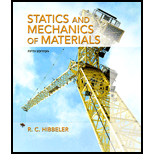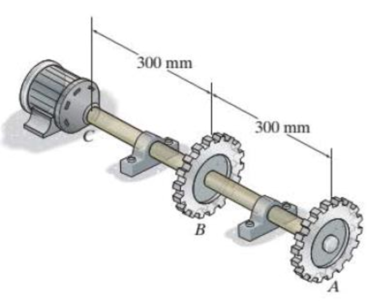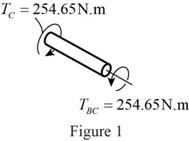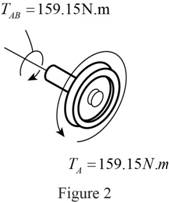
Concept explainers
The shaft is made of A992 steel and has an allowable shear stress of τallow = 75 MPa. when the shaft is rotating at 300 rpm, the motor supplies 8 kW of power, while gears A and B withdraw 5 kW and 3 kW, respectively. Determine the required minimum diameter of the shaft to the nearest millimeter. Also, find the rotation of gear A relative to C.

Probs. R10-1/2
Find the required minimum diameter of the shaft and the angle of twist of gear A relative to gear C.
Answer to Problem 1RP
The required minimum diameter of the shaft is
The angle of twist of gear A relative to gear C is
Explanation of Solution
Given information:
The allowable shear stress in the shaft is 75 MPa.
The motor supplies power of 8 kW.
Gear A and B withdraws power of 5 kW and 3 kW.
Shaft rotates at 300 rpm.
Calculation:
The expression for angular velocity of the shaft
Here, f is the frequency of shaft’s rotation.
Substitute
The expression for the power transmitted
Here, T is the applied torque and
Rearrange Equation to find the torque at A.
Here,
Substitute 5 kW for
Find the torque at C.
Here,
Substitute 8 kW for
Sketch the internal torque in the segment BC of the shaft as shown in Figure 1.

Sketch the internal torque in the segment AB of the shaft as shown in Figure 2.

Refer Figure 1 and Figure 2.
Segment BC of the shat is subjected to a greater internal torque of
The outer radius of the shaft is r.
The polar moment of inertia for a solid shaft of radius
The torsion formula for allowable maximum shear stress in the solid shaft
Here,
Substitute r for c and
Substitute 75 MPa for
The diameter of the shaft is twice the radius of the shaft. So the value of diameter is 26 mm.
Therefore, the required minimum diameter of the shaft is
Refer Figure 2.
The torque in the region AB of the shaft is
Refer Figure 1.
The torque in the region BC of the shaft is
Refer the properties of A992 steel.
The value of shear modulus of elasticity of A992 steel is 75 GPa.
The value of radius of the solid shaft is 13 mm.
Determine the angle of twist
Here, L is the length of the shaft and G is the shear modulus of elasticity of the material.
Rearrange Equation for angle of twist of gear A relative to gear C
Substitute
Substitute
Therefore, the angle of twist of gear A relative to gear C is
Want to see more full solutions like this?
Chapter 10 Solutions
Statics and Mechanics of Materials (5th Edition)
- This is an exam review question. The answer is Pmin = 622.9 lb but whyarrow_forwardPlease do not use any AI tools to solve this question. I need a fully manual, step-by-step solution with clear explanations, as if it were done by a human tutor. No AI-generated responses, please.arrow_forwardPlease do not use any AI tools to solve this question. I need a fully manual, step-by-step solution with clear explanations, as if it were done by a human tutor. No AI-generated responses, please.arrow_forward
- Please do not use any AI tools to solve this question. I need a fully manual, step-by-step solution with clear explanations, as if it were done by a human tutor. No AI-generated responses, please.arrow_forwardThis is an old practice exam. Fce = 110lb and FBCD = 62 lb but whyarrow_forwardQuiz/An eccentrically loaded bracket is welded to the support as shown in Figure below. The load is static. The weld size for weld w1 is h1 = 4mm, for w2 h2 = 6mm, and for w3 is h3 =6.5 mm. Determine the safety factor (S.f) for the welds. F=29 kN. Use an AWS Electrode type (E100xx). 163 mm S 133 mm 140 mm Please solve the question above I solved the question but I'm sure the answer is wrong the link : https://drive.google.com/file/d/1w5UD2EPDiaKSx3W33aj Rv0olChuXtrQx/view?usp=sharingarrow_forward
- Q2: (15 Marks) A water-LiBr vapor absorption system incorporates a heat exchanger as shown in the figure. The temperatures of the evaporator, the absorber, the condenser, and the generator are 10°C, 25°C, 40°C, and 100°C respectively. The strong liquid leaving the pump is heated to 50°C in the heat exchanger. The refrigerant flow rate through the condenser is 0.12 kg/s. Calculate (i) the heat rejected in the absorber, and (ii) the COP of the cycle. Yo 8 XE-V lo 9 Pc 7 condenser 5 Qgen PG 100 Qabs Pe evaporator PRV 6 PA 10 3 generator heat exchanger 2 pump 185 absorberarrow_forwardQ5:(? Design the duct system of the figure below by using the balanced pressure method. The velocity in the duct attached to the AHU must not exceed 5m/s. The pressure loss for each diffuser is equal to 10Pa. 100CFM 100CFM 100CFM ☑ ☑ 40m AHU -16m- 8m- -12m- 57m 250CFM 40m -14m- 26m 36m ☑ 250CFMarrow_forwardA mass of ideal gas in a closed piston-cylinder system expands from 427 °C and 16 bar following the process law, pv1.36 = Constant (p times v to the power of 1.36 equals to a constant). For the gas, initial : final pressure ratio is 4:1 and the initial gas volume is 0.14 m³. The specific heat of the gas at constant pressure, Cp = 0.987 kJ/kg-K and the specific gas constant, R = 0.267 kJ/kg.K. Determine the change in total internal energy in the gas during the expansion. Enter your numerical answer in the answer box below in KILO JOULES (not in Joules) but do not enter the units. (There is no expected number of decimal points or significant figures).arrow_forward
- my ID# 016948724. Please solve this problem step by steparrow_forwardMy ID# 016948724 please find the forces for Fx=0: fy=0: fz=0: please help me to solve this problem step by steparrow_forwardMy ID# 016948724 please solve the proble step by step find the forces fx=o: fy=0; fz=0; and find shear moment and the bending moment diagran please draw the diagram for the shear and bending momentarrow_forward
 International Edition---engineering Mechanics: St...Mechanical EngineeringISBN:9781305501607Author:Andrew Pytel And Jaan KiusalaasPublisher:CENGAGE L
International Edition---engineering Mechanics: St...Mechanical EngineeringISBN:9781305501607Author:Andrew Pytel And Jaan KiusalaasPublisher:CENGAGE L Mechanics of Materials (MindTap Course List)Mechanical EngineeringISBN:9781337093347Author:Barry J. Goodno, James M. GerePublisher:Cengage Learning
Mechanics of Materials (MindTap Course List)Mechanical EngineeringISBN:9781337093347Author:Barry J. Goodno, James M. GerePublisher:Cengage Learning

